This post may contain affiliate links. Please read our disclosure policy.
Learn how to make the perfect pandan chiffon cake with this foolproof, step-by-step guide. Includes tips, troubleshooting, and sizing for any pan—ideal for beginners and seasoned bakers alike.
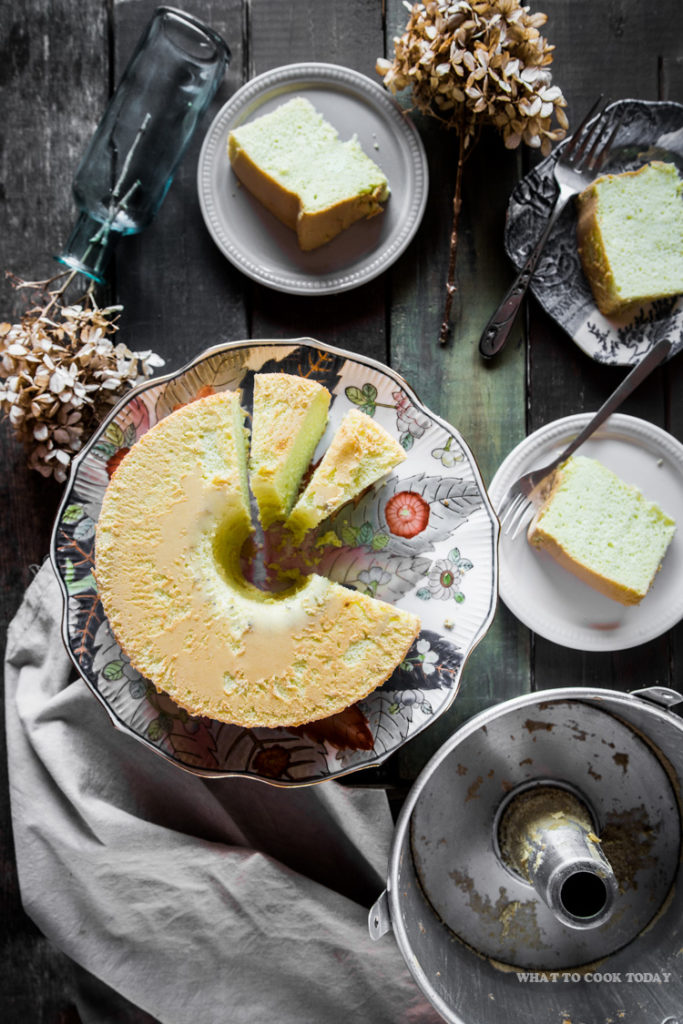
This pandan chiffon cake holds a special place in my heart. Growing up in Indonesia, this cake was a staple at family gatherings and celebrations. Its vibrant green color and sweet, fragrant aroma bring back memories of my grandma baking it in our small kitchen with the unmistakable smell of pandan filling the air. It was one of the first cakes I learned to bake after I moved to Minnesota, and to this day, it remains one of my all-time favorites. There’s something so comforting about its fluffy, cloud-like texture paired with the tropical scent of pandan that feels like home.
What Is Chiffon Cake and What Is Pandan Chiffon Cake?
Chiffon cake is a light, airy cake created in the 1920s by an American baker, Harry Baker. Chiffon cake always uses oil instead of butter and relies on whipped egg whites for volume, resulting in a tender and cloudlike texture.
Pandan chiffon cake is a beloved variation in Southeast Asia, particularly in Indonesia, Malaysia, and Singapore. It incorporates pandan juice or extract, which gives the cake its signature vibrant green hue and a floral, vanilla-like aroma that’s uniquely Southeast Asian.
What Makes Chiffon Cake So Soft and Fluffy?
Several key techniques and ingredients give chiffon cake its trademark lightness:
1. Oil instead of butter keeps the crumb moist and tender even after refrigeration.
2. Whipped egg whites (meringue) are folded into the batter, giving the cake volume and airiness.
3. Cake flour or low-protein flour helps create a fine, soft crumb.
Understanding the Ingredients in Pandan Chiffon Cake
Let’s break down each key ingredient:
1. Eggs: You’ll separate them—whites for the meringue and yolks for the batter. Use large eggs (about 58–60g each in the shell).
2. Sugar: If you have fine sugar like caster sugar, you can use that. I usually just use granulated sugar, which is more common in the U.S. and it works just fine
3. Cake flour: Low-protein flour yields a more tender cake. Substitute with all-purpose flour + cornstarch if needed (more about it in FAQ section on how to make your own in a pinch)
4. Cornstarch: It helps absorb some of the liquid in the batter and slows down gluten development, resulting in a finer, more delicate crumb—important for chiffon cakes, which should be light and airy.
4. Oil: Neutral oil like avocado oil or grapeseed ensures a moist texture.
5. Pandan extract: Fresh pandan extract gives the best flavor, but quality pandan essence can give you a brighter color. Don’t overdo it—too much can make the cake bitter or grassy.
6. Coconut milk : Use canned coconut milk and not the liquid coconut milk for beverage
7. Cream of tartar: Helps stabilize the egg whites. But you can also use acid like lemon juice or vinegar
Pro Tips for a Perfect Pandan Chiffon Cake
1. Clean equipment is crucial for whipping egg whites—no yolk or grease!
2. Use room-temperature eggs
Separate the yolks from the whites when they are still cold. It’s easier to do when the eggs are cold. Put the egg whites in the mixing bowl of a stand mixer and the yolks in another large mixing bowl for the cake batter
3. Add sugar gradually
Don’t dump all the sugar into the egg whites. You want to add them batch by batch for proper meringue development
4. Don’t overbeat the meringue—stiff peaks should hold with a slight bent on the tip. The meringue appears smooth and glossy
5. Fold gently—overmixing will deflate your batter. I usually fold the meringue into he cake batter using a whisk for the first two rounds and then switch to a rubber spatula on the last round to ensure nothing at the bottom of the bowl is left behind. This way everything is evenly combined. You shouldn’t see anymore white meringue floating in your cake batter
6. Bake long enough—undercooked cakes collapse. Use a skewer to check.
7. Cool completely upside down to maintain structure.
What is slit-top method for Chiffon Cake?
I recently really enjoyed doing the slit-top method for chiffon cake.
The slit top method in chiffon cake is a technique where you score or cut a shallow slit along the top center of the batter after it has been poured into the pan and bake at higher temperature for short period of time. Here are why:
1. Professional Look: The resulting cake surface looks more intentional and tidy, which is useful if you plan to serve it undecorated or with minimal toppings.
2. Controls the Crack: Chiffon cakes often crack during baking because of the rapid rise. The slit gives the batter a controlled path to expand, so any cracking happens neatly along the slit, rather than randomly across the top.
3. More Even Rise: It can help the cake rise more symmetrically and evenly, reducing doming or lopsided tops.
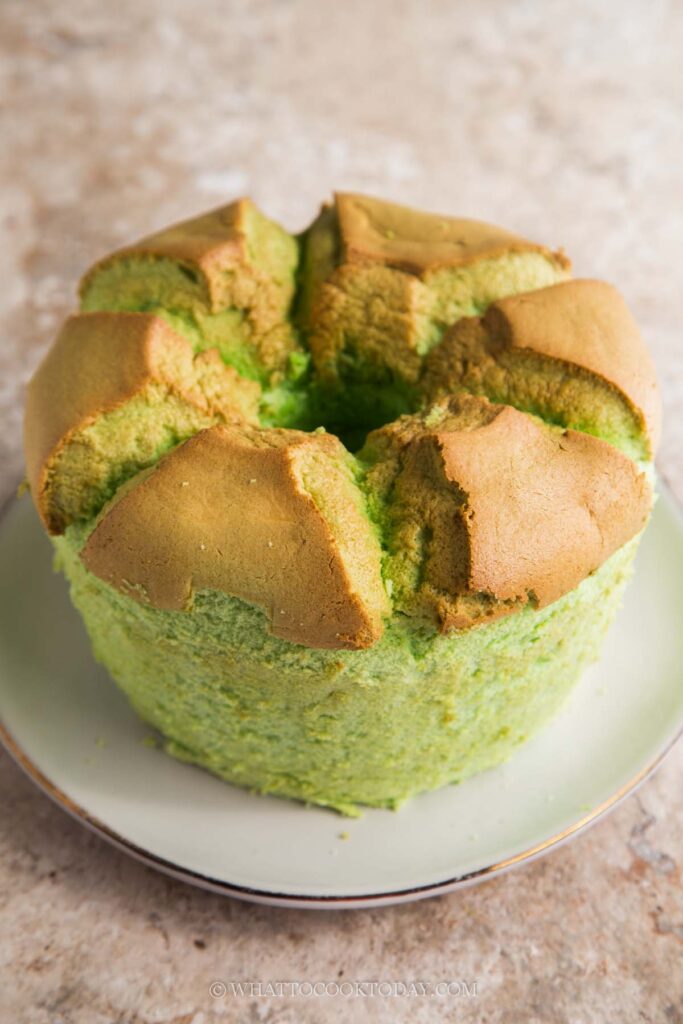
Troubleshooting Tips for Chiffon Cake
1. Chiffon cake flops out from the pan when I invert it upside down to cool down
The causes can be one of the combinations of any of the following:
–The cake is undercooked. The side and the bottom of the cake aren’t brown enough and don’t cling to the pan and that’s why the cake slips out when you invert it. Even if you don’t invert it, this cake will shrink and collapse on its weight.
How to fix this: bake it a bit longer and use an oven thermometer if you suspect that your oven is not accurate
– The side and the bottom of the cake are brown enough but the cake still slips out. This could be there’s too much liquid in the cake, the cake is too wet and the result is an underbaked cake and the heavyweight pulls the cake down and out of the pan, and it goes.
How to fix this: you need to double-check the recipe and make sure you measure with a kitchen scale to make sure the number of ingredients is correct
2. The side of the cake caves in
The cake looks like it has a “waist”. You are either overbeating or not beating the meringue enough. Overbeaten or underbeaten meringue will be clumpy and foamy and doesn’t mix well with the batter.
How to fix this: make sure you beat the meringue to the stiff peak but with a slight bent on the tip
3. The top of the cake cracks
To be honest, this is NOT an issue at all. I know we want that perfect-looking cake, but cracks are not a bad thing. This will become the bottom of the cake anyway. Besides, when it has some cracks, it tells you that the cake is not going to be underbaked. I’m more concerned with an underbaked chiffon cake than a bit overbaked. An underbaked chiffon cake will collapse and shrink badly.
How to fix this: You can try to move the cake down a bit or adjust your oven setting, but really, I won’t bother trying to fix this as long as the cake is soft, fluffy, and bouncy.
4. The bottom of the cake concaves in
Your oven temperature is too high. When the cake rises and expands too quickly, it will shrink even more as it cools down. How to fix this: Lower the temperature and monitor. Get an oven thermometer if you suspect that your oven temperature may not be accurate
5. My chiffon cake won’t rise tall
There could be one or several causes:
– Your tube pan has a non-stick coating and/or you grease your pan
– Your meringue is over or underbeaten.
Either one is not good. Over or underbeaten meringue is clumpy and foamy and won’t mix well with the batter, hence, your batter and the meringue aren’t combined. Even if your cake rises during baking, it will deflate when you cool it down
– You deflate too much of the air when you fold the meringue into the batter
– The oven temperature is too low. The heat is not enough for the cake to rise and so you will end up with a short and some dense layer inside the cake
– You open the oven door during baking
6. My chiffon cake rises tall in the oven and deflates when I took it out of the oven
– The oven temperature is too high that the cake rises too quickly and then shrinks badly
– The cake is not baked long enough
7. My chiffon cake has large “pores” in the crumbs
– Too many air bubbles are trapped inside the batter. Make sure you tap the pan a few times before baking and drawing a zigzag using a skewer inside the batter helps to pop those bubbles too
– Too much baking powder can cause this issue too. Using baking powder usually yields a bit taller cake than not using one,, there would be more air holes inside the cake no matter how much effort I put in to pop those bubbles.
8. My chiffon cake feels wet
– It could be too much liquid in the cake recipe
– Your oven temperature may be too low or inaccurate
– You probably just need to bake the cake a bit longer. Every oven can be different, so you need to know your oven
9. My chiffon cake shrinks
It is normal for chiffon cake to shrink a bit after it has cooled down, but it shouldn’t collapse or lose half of its weight. It could be that you don’t whip the meringue correctly, the cake is underbaked, you open the oven door during baking, or you didn’t invert the cake pan immediately after baking.
10. My chiffon cake turns out short
-Make sure you use the correct size of tube pan for the recipe. If your pan is too big and you don’t have enough batter, the cake will be shorter than it should be
-I use large size egg, which usually weighs about 56-58 grams of egg when you weigh with the shell. The yolk usually weighs about 18-20 grams each and the white weighs 28-30 grams each
Frequently Asked Questions
Q: What kind of pan do I need to bake chiffon cake?
A: You need a tube pan with a removable-bottom piece. The pan also cannot have a non-stick coating. This is very important because chiffon cake relies on the pan and the tube in the middle to help it climb tall without collapsing.
Q: Can I bake chiffon cake in a regular cake pan?
A: A chiffon cake needs a tube pan to climb and rise properly. Regular pans don’t provide the same structure. So, I would say NO.
Q: Why can’t I grease the pan?
A: The cake needs to cling to the sides of the pan to rise. Greasing it would cause it to collapse because the batter would not be able to cling to the pan to help it rise tall.
Q: Why do eggs need to be at room temperature?
A: Room temperature egg whites whip more easily and reach greater volume than cold ones. The proteins in the whites loosen up as they warm, allowing them to trap more air when beaten. This leads to a more stable meringue and ultimately a fluffier chiffon cake. I recommend separating the eggs when they are cold and then letting them sit for 30 minutes or so at room temperature
Q. Why do we need cream of tartar?
A: Adding an acid like cream of tartar (or lemon juice or vinegar) helps to stabilize the egg whites during whipping. The acid lowers the pH, which loosens the egg white proteins just enough to allow them to stretch and hold air more effectively. This results in a stronger, more stable meringue that’s less likely to collapse when folded into the batter or baked.
Q. How do I know if I whip the meringue to a stiff peak?
A: When you lift the whisk, the meringue should stand tall and straight with a slight bend on the tip (like a tiny hook). The meringue should also look glossy and smooth, not grainy or clumpy. If you tilt the bowl, the meringue should stay put and not slide around.
Q: How do I know if the meringue is overwhipped?
The meringue will look dry and clump together — it won’t incorporate well into the cake batter, and you will see flops of egg whites here and there. Your cake will most likely collapse or come out dense when you bake it
Q: How do I know if the meringue is underwhipped?
Your peaks will be very soft and bent a lot when you lift the whisk. When you combine it with the cake batter, it turns very watery and loses most of the air bubbles already before baking
Q: Can I use all-purpose flour?
A: Yes you can, but the cake won’t be as fluffy
Q: How to make cake flour?
A: Yes, you can make your own cake flour in a pinch. Here’s how to make: Sift together 110 grams (3/4 cup + 2 Tbsp) of all-purpose flour with 16 grams (2 Tbsp) of cornstarch. Store them in an air-tight container and use the amount you need. Simply double or triple the amount to make extra
Q: Can I use pandan extract instead of fresh juice?
A: Yes! Use a high-quality extract or paste, but only a small amount—a little goes a long way.
Q: Should I use baking powder in chiffon cake?
A: In most cases, you don’t need baking powder for a chiffon cake if your meringue is properly whipped to stiff peaks. The air trapped in the meringue is what gives the cake its rise and airy texture.
However, using a small amount of baking powder can serve as a kind of “insurance policy”—especially helpful if you’re worried your meringue might be slightly under-whipped or you’re new to making chiffon cakes. I have included the amount of baking powder in the recipe if you choose to use it
Q: How to store chiffon cake?
A: Chiffon cake is best enjoyed the day it’s made, but it stores well at room temperature for about 2-3 days. If it’s really humid where you are, maybe limit it to 2 days. You can also store them in the fridge, but I don’t really like to keep chiffon cake in the fridge because fridge tends to dry out the cake more. I prefer to freeze chiffon cake.
Q: Can I freeze chiffon cake?
A: Contrary to the belief that chiffon cake or any sponge cake is so fragile that it won’t freeze well, I find the opposite. I bake so much, and I freeze my chiffon cakes and sponge cakes all the time. It’s so much better than keeping them in the fridge, which will dry them out. Here’s how:
1. Let the cake cool down completely
2. If uncut, wrap the whole cake in a cling wrap, 2 layers would be best, and then wrap with foil on the outside. If you have a box for it, put it inside; if not, don’t worry about it. Put it in a spot where it won’t get squished while it’s still not completely frozen
3. If cut into slices, wrap 2-3 slices together with a cling wrap, then the foil, and put inside a freezer bag, push all the air out and seal
4. When ready to serve, thaw at room temperature and they are ready to be consumed. Try not to freeze for more than one month

Soft and Fluffy Pandan Chiffon Cake Recipe and Video (Complete Guide)
Ingredients
Please use digital kitchen scale to weigh ingredients (Cup measurement is not recommended):
PANDAN JUICE (you will have leftover):
- 70 g pandan leaves about 15 large pieces of pandan leaves
- 100 g water
RECIPE FOR 15 CM (6 INCHES) TUBE PAN:
Dry ingredients:
- 60 g cake flour
- 8 g cornstarch
- ¼ tsp salt
- ¼ tsp baking powder optional
Wet ingredients:
- 60 g egg yolks (room temperature) 3 large eggs (yolk is 18-20 grams each)
- 11 g sugar
- 15 g pandan extract see notes 1
- ½ tsp pandan essence
- 38 g cooking oil
- 53 g canned coconut milk well-shaken before opening the can
Meringue:
- 90 g egg whites (room temperature) 3 large eggs (white is 28-30 grams each)
- ¼ tsp cream of tartar or use 1/2 tsp of lemon juice or vinegar
- 45 g sugar
RECIPE FOR 18 CM (7 INCHES) TUBE PAN:
Dry ingredients:
- 80 g cake flour
- 10 g cornstarch
- ¼ tsp salt
- ½ tsp baking powder optional
Wet ingredients:
- 80 g egg yolks (room temperature) 4 large eggs (yolk is 18-20 grams each)
- 20 g pandan extract see notes 1
- ¾ tsp pandan essence
- 50 g cooking oil
- 20 g sugar
- 70 g canned coconut milk well-shaken before opening the can
Meringue:
- 120 g egg whites (room temperature) from 4 large eggs (white is 28-30 grams each)
- ½ tsp cream of tartar or use 1 tsp of lemon juice
- 60 g sugar
RECIPE FOR 20 CM (8 INCHES) TUBE PAN:
Dry ingredients:
- 100 g cake flour
- 13 g cornstarch
- ¼ tsp salt
- ¾ tsp baking powder optional
Wet ingredients:
- 100 g egg yolks (room temperature) 5 large eggs (yolk is 18-20 grams each)
- 25 g pandan extract see notes 1
- 1 tsp pandan essence
- 63 g cooking oil
- 25 g sugar
- 88 g canned coconut milk well-shaken before opening the can
Meringue:
- 150 g egg whites (room temperature) 5 large eggs (white is 28-30 grams each)
- ½ tsp cream of tartar or use 1 tsp of lemon juice or vinegar
- 75 g sugar
RECIPE FOR 22 CM (9 INCHES) TUBE PAN:
Dry ingredients:
- 120 g cake flour
- 15 g cornstarch
- ⅓ tsp salt
- ¾ tsp baking powder optional
Wet ingredients:
- 120 g egg yolks (room temperature) 6 large eggs (yolk is 18-20 grams each)
- 30 g pandan extract
- 1 ¼ tsp pandan essence
- 75 g oil
- 30 g sugar
- 105 g canned coconut milk well-shaken before opening the can
Meringue:
- 180 g egg whites (room temperature) 6 large eggs (white is 28-30 grams each)
- ½ tsp cream of tartar or use 1 1/4 tsp of lemon juice or vinegar
- 90 g sugar
RECIPE FOR 26 CM (10 INCHES) TUBE PAN:
Dry ingredients:
- 160 g cake flour
- 20 g cornstarch
- ½ tsp salt
- 1 tsp baking powder optional
Wet ingredients:
- 160 g egg yolks (room temperature) 8 large eggs (yolk is 18-20 grams each)
- 40 g pandan extract see notes 1
- 1 ½ tsp pandan essence
- 100 g oil
- 40 g sugar
- 140 g canned coconut milk well-shaken before opening the can
Meringue:
- 240 g egg whites (room temperature) 8 large eggs (white is 28-30 grams each)
- ¾ tsp cream of tartar or use 1 1/4 tsp of lemon juice or vinegar
- 120 g sugar
Instructions
Important things to note before you start baking:
- I think it's helpful to read my blog post entirely to understand the basic of chiffon cake if you are new to baking chiffon cake or want to bake better chiffon cake. Check out the table of contents above that covers lots of tips, troubleshootings, FAQ, etc.
- If you want to bake chiffon cake as cupcakes, the baking temperature and instructions are different. Please follow this recipe instead
- Make sure your chiffon cake pan does not have a non-stick coating or your cake will not rise. The cake needs to cling to the side of the pan to rise tall
- I use large size egg that weigh about 56-58 grams each when weighed with the shell. The yolk is about 18-20 gram each and the white is about 28-30 grams each
- I also decided to provide the weight of the egg yolks and egg whites for consistency. Each country has slightly different definition on size of eggs, etc. It's best if you use the weight instead of just going by the number of eggs. Sometimes you may need less or more eggs to get to the weight provided in the recipe, for example the eggs you use maybe smaller or larger than the ones I use.
- Before you start making the recipe, make sure eggs, pandan juice, and coconut milk (if you keep in the fridge) are at room temperature. Separate the egg yolks from the whites when they are still cold. It's easier that way. Then let them sit at room temperature for about 30 minutes before whipping the meringue.

Make pandan extract: (prepare a day or two before if you can)
- Make sure you cut the leaves into little pieces to extract the juice out from the leaves.
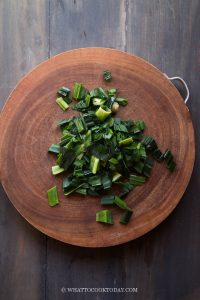
- Put in a blender and add water and process for a minute or so or until it becomes paste-like. Transfer to a cheesecloth or muslin cloth or use a strainer to squeeze the juice out. Let the pandan juice sit for at least 30 minutes. Preferably 1-2 days before if you plan ahead. The juice will separate and the sediment will sink to the bottom. Pour out the watery portion on top and measure out the amount of pandan extract you need and keep the leftover in the fridge for up to one week

- Pandan essence is optional. It does make the color a bit brighter and the flavor a bit stronger but you don't have to use it if you want to
Preheat the oven:
- If you choose to do slit-top version: start preheating the oven at 385 F (195 C) for conventional oven. For convection oven,lower the temperature by 20 F (15 C). Position the rack to the lower 3rd of the oven
- If you choose to do regular bake without the slit: start preheating the oven at 330 F (165 C) for conventional oven. For convection oven,lower the temperature by 20 F (15 C). Position the rack to the lower 3rd of the oven
Prepare the cake batter:
- Whisk the egg yolks, cooking oil, sugar, then add coconut milk and pandan extract and essence. Sift in the cake flour, cornstarch and salt into the batter, there will be no lumps when you do this. Whisk to mix into a smooth batter. Set aside

Whipping the meringue:
- Beat the egg whites on medium speed until frothy for about 30 seconds. Then add cream of tartar or lemon juice/vinegar

- Whip until it turns whitish and air bubbles are fine, another 30 seconds.

- Gradually add the sugar as you beat, in 3 batches. I beat them at medium speed (speed 4 on Kitchen Aid). This will take a bit longer compared to beating at high speed. I used to do higher speed (speed 6 or even 8), but the meringue is smoother and nicer when I maintain the speed on 6. I highly recommend stopping several times to check on the consistency and scraping the sides of the bowl to make sure no sugar left on the side of the bowl.
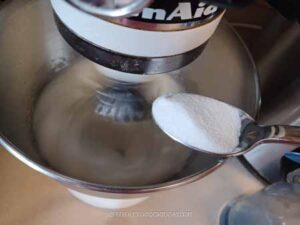
Check the meringue:
- Whip until you reach a stiff peak but still have a slight bent on the tip. When you lift the whisk up, the meringue should stand tall with a slight bent on the tip like a hook. Then lower the speed to the lowest and whip for about 30 seconds to minimize air bubbles


How to know if you have overbeaten the meringue:
- If you beat until the meringue clumps on the whisk attachment in one HUGE chunk/lump, you know you've gone too far beating the meringue. You will have to start over when you overbeat the meringue. If you use it, the meringue will separate when you fold it into the yolk batter and won't hold much air and your cake will deflate later
Fold meringue into the cake batter:
- Gently fold 1/3 of the meringue into the thick batter.

- Using a whisk, using a cutting motion and fold over to mix. Repeat this motion several rounds.

- Continue on with the second 1/3 of the meringue again to mix. For the last 1/3 of the meringue, use a rubber spatula instead to ensure you get all the batter at the bottom of the bowl mixed in as well. Use a cut down in the middle and fold over motion to fold gently but quickly. Make sure you don't see any more white meringue. The mixture should be fluffy and voluminous and pourable consistency


- Pour the batter into an UNGREASED chiffon cake pan. Use a skewer to draw a zig zag to pop bubbles inside the cake batter and to even out the batter throughout the pan. Use a rubber spatula to smooth the surface. Gently drop the cake pan from about 10 cm height on the counter 2-3 times.

Bake (If you choose to do the slit-top version):
- Please note that the baking temperature in the video is slightly different than in this recipe. Please follow the baking temperature in this recipe post and not the video. I haven't had a chance to update the video yet.
- Please read my post above why I like the slit-top method if you are curious. You can check out this YouTube Short for how the slit-top method is done.
- Bake at 385 F (195 C) for 13–14 minutes,
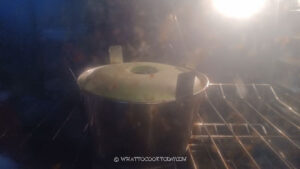
- Then quickly remove the cake from the oven and slit the top lengthwise, about 1/2-inch deep, with a sharp knife (this helps it rise evenly following the slit lines). Wipe the knife after each slit. Try to complete this in less than 1 minute.

- Return to the oven, reduce the heat to 330 F (165C), and bake for For 6-inch tube: Bake for 50 minutes, For 7-inch tube: Bake for 55 minutes, For 8-inch tube: Bake for 60 minutes,For 9-inch tube: Bake for 65 minutes, For 10-inch tube: Bake for 70 minutes For convection oven,lower the temperature by 20 F (15 C)
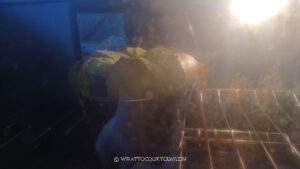
Bake (without the slit-top):
- This chiffon cake recipe has higher liquid and therefore we need to make sure it is baked long enough. Pop into the oven and place on the positioned rack. For 6-inch tube: Bake for 35 minutes, For 7-inch tube: Bake for 40 minutes, For 8-inch tube: Bake for 45 minutes,For 9-inch tube: Bake for 50 minutes, For 10-inch tube: Bake for 55 minutes
- DO NOT open your oven door during the baking time. The cake will deflate.
- Without opening the oven door, increase temperature to 350 F (180 C) for conventional oven, If you have a convection oven, I suggest lowering the temperature by 20 F (15 C). Then bake for another 10 minutes.
- NOTES on baking time: Please note that the baking time is just for reference. Your oven may bake faster or slower and the type of oven you use may be different than mine.
Test for doneness:
- I know this is weird to say, but it's actually "safer" to overbake chiffon cake than underbaking. Underbaking tends to cause the cake to collapse. If you insert a skewer into the cake, it should come out completely clean.
- Don't be alarm if your cake has some cracks on top. What you are looking at will become the bottom of your cake. I know many people mind it a lot and make a big fuss when the top of the chiffon cake cracks, but actually it's not a flaw.
Invert to cool down immediately:
- Once out of the oven, drop the cake pan from about 10 cm height on the counter several times to prevent shrinkage. Then carefully invert the pan upside down immediately. Your chiffon pan may have the little stands for you to invert. Please don't be tempted to remove from the pan if it's still warm. It takes about three to four hours to cool completely

- If the top of the cake is sticky to the touch after it has cooled down, next time you know you can add another 5 minutes to the baking time and see. It does require some experiment on your part as every oven may be different
- Once it's cool down completely, use an offset spatula and press it firmly against the pan, sort of angling the spatula a bit and run through the edge as you turn the pan. This will ensure the brown crust won't peel off by the spatula. Some may peel off, but majority should be there. Gently push the base to lift the cake out. Use an offset spatula again, firmly press towards the pan and run through the base of the pan and then carefully release the cake.

- For the slit-top chiffon cake, the cake can be placed upside down like usual, or with the slit top on top

Marv’s Recipe Notes
- If you don’t have pandan extract, just replace it with more coconut milk or milk (dairy/non-dairy for a richer taste) and use the pandan essence instead

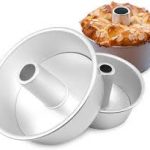
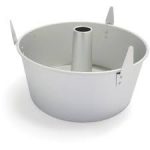
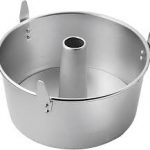

189 comments
hi thanks for the recipe. may i know if i am using 30ml pandan juice does it mean that the coconut milk only need 70ml?
Hi Selina, you will still use 30 ml pandan juice + 100 ml of coconut milk. If you use concentrated pandan extract or essence, which only needs 1 1/2 tsp, then you will use total of 130 ml of coconut milk. I hope it makes sense?
Can I use pandan extract?
If yes, how much should I added in for pandan juice replacement?
Hi EY, yes you can use pandan extract, you can try 1 to 1 1/2 tsp of pandan extract and top up the rest of the liquid replacement with a bit extra coconut milk. Hope this helps!
I love pandan, and chiffon cake is my favourite. What a great idea, Marvellina! –Your pictures are gorgeous. As usual 🙂
We LOVE this cake! We have it once every few yrs when i brought back from Jkt. I’m going to make this one day after i mastered the ongol2 (that’s another story?)
What a scrumptious looking cake! Pinned! 🙂
Thank you Marsha !! 🙂